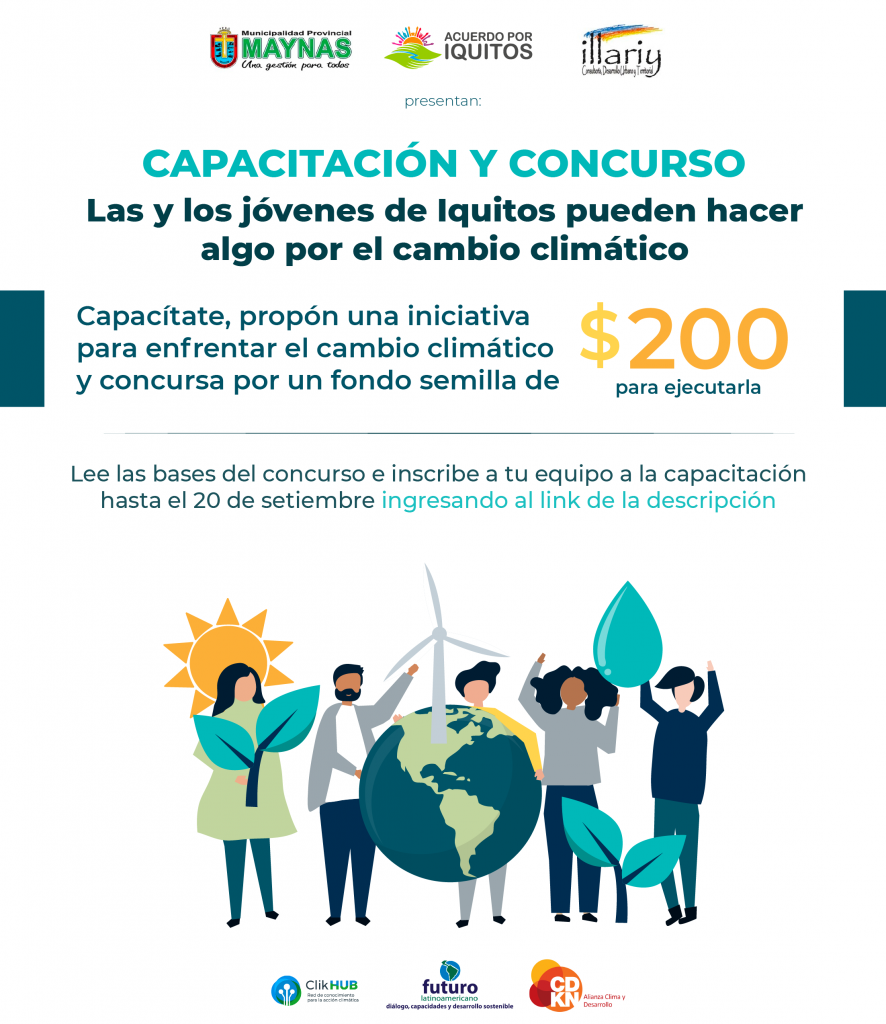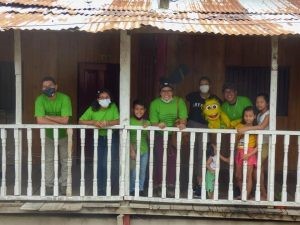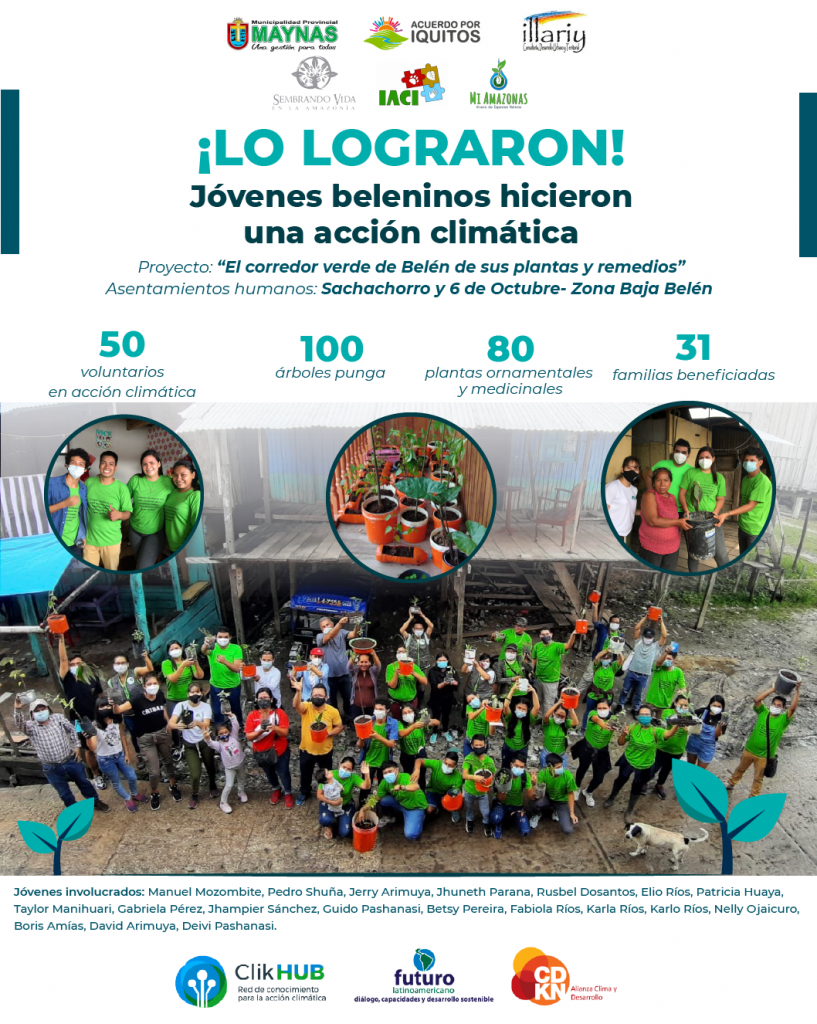Iquitos, Peru: Youth as key players in tackling climate change
Iquitos, Peru: Youth as key players in tackling climate change
Today’s youth will bear the brunt of climate change, but they can also potentially take a leading role in tackling it. That’s why it is important to involve young people in climate change actions in their communities – reports CDKN’s Maria Jose Pacha. In Iquitos, Peru, young people are leading the way.
An example of youth climate action comes from the city of Iquitos, in Peru. A project to support young people's initiative was devised by participants on a course titled Effective Communication on Climate Change and run by CDKN and the Clikhub in May - June 2020.
Participants in the CDKN course had the opportunity to generate project ideas on the topic of communication on climate change in Latin America. Of these, five ideas were selected to receive seed funding from CDKN. Maritza Mayo D’Arrigo – one of the course participants – proposed an idea that was selected for funding.
Maritza’s project, Youth as key players in tackling climate change in Iquitos, trained up young people from Iquitos on climate change, who then took part in a competition. The winners were awarded a small grant for implementation of their proposed climate actions.
It was a collaboration with Illariy Urban and Territorial Development Consulting, The Municapality of Maynas and local organisations that belong to the Iquitos Agreement (The Iquitos Agreement is a collective of civil society organisations seeking consensus on a new vision for the metropolitan city: Iquitos 2040). These local groups were: (i) The Tree of Life Foundation (NGO), (ii) Dessos, (ii) College of Architects of Peru - Loreto Regional and (iv) La Voz de la Selva Radio (Voice of the Jungle Radio).
The City of Iquitos and its climate change challenges
The project was implemented in the Iquito Amazon which falls under the Department of Loreto. The area is surrounded by three rivers, Itaya, Nanay and the Amazon river, making it almost an island and very susceptible to flooding. The area is mainly accessed by plane. Twenty percent of it constitutes flood land that is covered by water annually (Urban Development Plan for the Provincial Municipality of Maynas 2011).
During 2020, the provincial municipality of Maynas, the Iquitos Agreement and Illariy Consulting came together to raise awareness of climate change in Iquitos. This arose from the fact that climate change is being felt in the city, with rising temperatures, creation of urban heat islands, hurricane-force winds, and more frequent floods and droughts.
Up-skilling young people: The digital divide
The project focused on two groups: youth in high-quality education streams and youth from impoverished areas in low-quality education streams. On 10 September 2020, during the annual city conference, the Iquitos Agreement presented these two opportunities to young people in the city, via a climate change exhibition, and invited them to register to take part.
Face-to-face attendance of the training was not considered an option due to the COVID-19 pandemic and the heavy impact it has had on the Department of Loreto and the city of Iquitos. However, the region has the highest digital divide in the country with more than 80% of households lacking internet access. This inequality in internet access became a key issue for delivering the training activities planned for the project. It was apparent that the participants signing up online came from privileged education streams. The youth living in an area called Baja de Belen could not participate online. As a result, the project coordinators decided to offer face-to-face training in households, in which family members participated. Between 14 to 50 youths in their 20s took part.
The training sessions began with activities led by Manuel Mozonite, one of the participants who took on a leadership role in the group. Participants had already been sent an outline of training topics in advance; and these topics were delivered through telephone calls – with the trainer providing coaching. The training covered various climate change issues and impacts on the city, heat islands, the importance of waste management, leadership and digital campaigns. Participants were assisted over two weeks in developing a project that they could submit in the small grants competition.
Poster (above): 'Young people of Iquitos can do something about climate change!' announcement of the small grants competition.
The climate action winner
Participants proposed their own climate actions and entered the small grants competition. The winners were a group of 20 youths from Belén Bajo who presented a project called The Belén Greenbelt and its plant remedies – your green neighbourhood, for a conscious generation in which the youth of Belén Bajo come together to tackle climate change.
Their project sought to involve residents in tackling climate change and raising awareness in households of the importance of green spaces. The main goal was to plant local, medicinal plants on balconies in homes and establish a plantation of 100 indigenous trees (Pseudobombax munguba) that are flood resilient.
Activities began early on 5 December with a theatre performance for children, the trees and plants were distributed to families and a breakfast was served. The event was also attended by representatives from the Agreement for Iquitos and the Provincial Municipality of Maynas.
Pictures (left and top, right): Residents of Iquitos at the delivery of trees and activities for children.
The event was attended by the 20 young people plus 20 more young activists and eight adults. Plants were distributed to 31 families from Sachachorro and 6 de Octubre.
Over and above the 100 indigenous trees, also known as Punga trees, Mi Amazonas nursery and Sembrando Vida and IACI made donations of 80 ornamental plants and 80 medicinal plants. In support of the initiative, filmmakers, Carla Salamanca and Nicolás Beltrán produced a video filmed in Belén to raise awareness of climate change and call people to action.
Poster (above) proclaims: 'They did it! The young people of Belen did something about climate change' (Belen is a district on the edge of the city of Iquitos)
The youth from this area have been inspired and motivated to continue with similar ventures. In post-project feedback, young neighbourhood leader, Manuel Mozombite said, ‘I am truly grateful for the support for the project implemented in Belén, it has changed the direction of the young men and women who participated, (Chat, 16 Dec. 21).
‘I am very grateful for the opportunity to participate in this group because I believe in the cause and I also want to change the world and make it a cleaner place. I want to teach people about recycling and not throwing waste into rivers and the streets if we want to live a healthy life and not contaminate our exquisite world’ - said Jesús Martín Olano Rojas, of Petronila Perea de Ferrando High School– 5th Grade.
‘The moment is now! Raise awareness and create new and future generations who treat the world with love and care. I had a very positive experience volunteering, I am grateful to have been part of this group and to have got to know each other and be part of a group of young people who are aware and look after the place where they live. There are many projects to be done and we should make it happen" - urged Rosario Fuentes.
The COVID-19 pandemic, lack of internet access and the increase in poverty experienced in 2020 all posed challenges to the organisational team in terms of project communication and roll-out of training.
Among the numerous lessons learned (in hindsight), one that stands out is that climate action is just as important as awareness raising, because it reaches beyond the direct beneficiaries of a specific project and has the capacity to involve the whole community. These actions can be very low cost and can harness youth leadership. And a pleasant surprise was how local artists from Lima got involved voluntarily by supporting the campaign through their arts.
The project sheds light on how important the youth are in mobilising climate actions that involve communities. It also proves that it is possible to overcome the digital divide created by the pandemic and that social networks are imperative for creating climate action.



